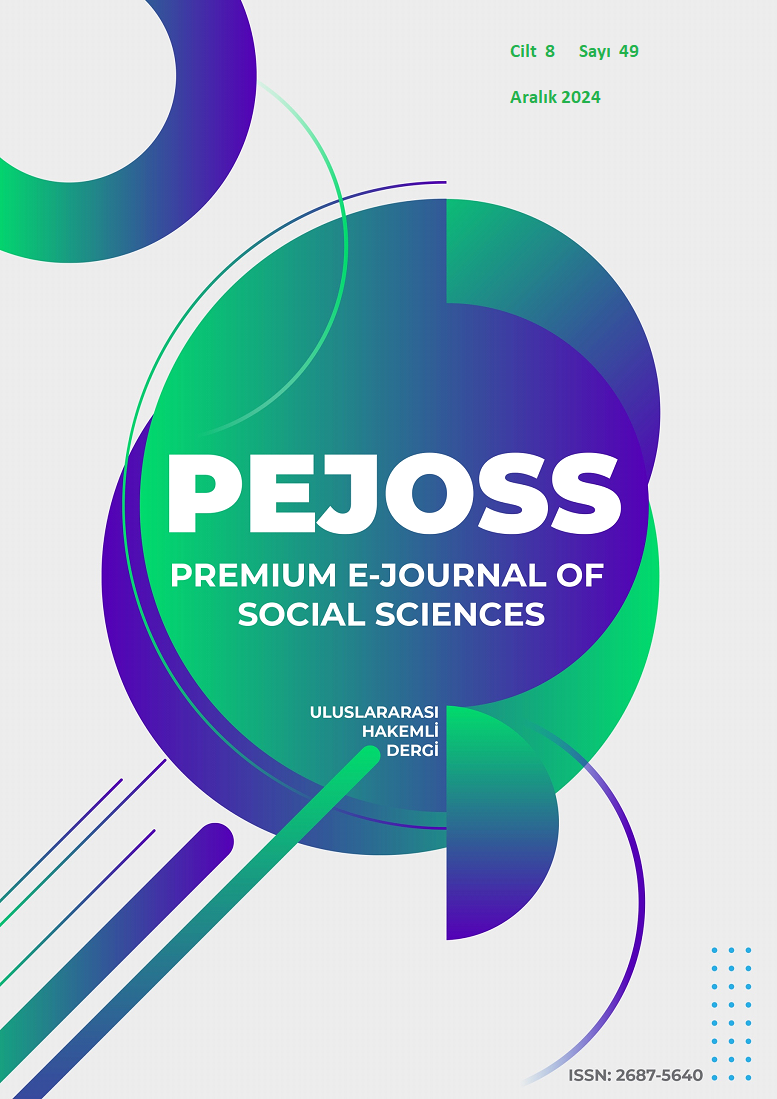Eco Playgrounds as a Means of Artistic Expression
DOI:
https://doi.org/10.5281/zenodo.14585716Keywords:
Ecology, eco-playground, sculpturalAbstract
The current state of the world climate requires creative experience environments that include effective suggestions for the environment that can be practically implemented. Current experience environments need to change due to new working paradigms. The language created to understand how people relate to nature as a society, how their personal beliefs and behaviors are affected, and how their actions are affected, indicates rational decision-making processes. The question of how to contribute meaningfully to global goals can be answered by creating environments that support sustainable, creative, and critical thinking in the environments where children and adults will spend time. Eco play environments, as creative areas that combine environmental sustainability and artistic expression, show that they can be a process of environmental improvement and solutions to future concerns. In this context, from an artistic perspective, eco play environments attract attention with designs that emphasize the aesthetics of nature and ecological balance. These areas allow artists to convey environmental messages through their actions. This study allows for socio-cultural definitions regarding the process of producing sculptures in eco-play environments that question the nature and definition of art and design in the social awareness interaction of individuals through different artist practices and expand the possibilities of expression of sculpture as a new way of telling art.
Downloads
References
Archdaily (t.y. a). Hand Knitted. https://www.archdaily.com/297941/meet-the-artist-behind-those-amazing-hand-knitted-playgrounds#
Archdaily (t.y. b). Hand Kintted. https://www.archdaily.com/297941/meet-the-artist-behind-those-amazing-hand-knitted-playgrounds/50afd440b3fc4b0cad0000d4-meet-the-artist-behind-those-amazing-hand-knitted-playgrounds-photo?next_project=no
Ardenne, P. (2019). Ecological Art-Ongoing, Reality, Becoming. Reiss J. (Ed.). Theory and practice in the anthropocene. United States: Vernon Press, 51-64.
Armstrong, R. (2021). Hughes, R. Deney Sanatı: 21. Yüzyıl Mimarisi ve Tasarımı İçin Pandemi Sonrası Bilgi Uygulamaları, Routledge.
Brady, E. (2013). The sublime in modern philosophy: Aesthetics, ethics, andnature. Cambridge University Press.
Brown, A. (2014). Sanat ve Ekoloji Şimdi, Thames & Hudson.
Boetzkes, A. (2019). Plastik Kapitalizm, Çağdaş Sanat ve İsrafa Yönelik Sürüş, MIT Press.
Demos, T.J. (2022). Sanat ve Ekoloji, Ali A. (Ed).( Çev. M. Tokmakçıoğlu, E. Sezgin). İletişim Yayınları.
Dezeen (2023) Kengo Kuma. https://www.dezeen.com/2023/09/22/kengo-kuma-earthscape-modular-wooden-playground-sculpture/
Drabble, B. (Ed.), (2019). Ekolojik Hatlar Boyunca-Çağdaş Sanat ve İklim Krizi, Gaia Projesi, Britannia Sanat Yayınları.
Earthscape (t.y.). Kengo Kuma. htttps://www.earthscapeplay.com/project/kengo-kuma-moku-yama-wood-mountain-playground-sculpture/
Ekoyapıdergisi (t.y.). Ekolojik Oyun Alanları. https://www.ekoyapidergisi.org/siradanligin-otesine-gecmek
Gzt (t.y.). Tophane Heykel Parkı. https://www.gzt.com/arkitekt/heykelsi-oyun-alani-tophane-park-playground-3768497
Hosmer, K. (2012). Vibrantly Colored Crocheted Playground, https://mymodernmet.com/vibrantly-colored-crocheted-playground/
Huızınga, J. (1995). “Homo Ludens – Oyunun Toplumsal İşlevi Üzerine Bir Deneme”, (Çev. M. A. Kılıçbay), Ayrıntı Yayınları.
Lappset (2024) Oyun Alanı. https://www.lappset.com/en-GB/article/leave-a-positive-handprint-on-the-future
Midstatesrecreation (2024). Lappset. https://midstatesrecreation.com/wpcontent/uploads/2024/03/Lappset_ Playgrounds-2024.pdf
Minniemuse (t.y.). Oyun Alanı. https://www.minniemuse.com/articles/musings/noguchi-playground
Morton, T. (2007). Doğa Olmadan Ekoloji, Çevresel Estetiği Yeniden Düşünmek, Harvard University Press.
Noguchi (t.y.) Noguchi Sculpture. https://archive.noguchi.org/
Parlsons, A. (2011). Youn Children and Nature: Outdoor Play and Development, Experiences Fostering Environmental Consciousness, and the Implications on Playground Design, Master Thesis, Virginia Polytechnic Institute and State University.
Sommer, L. K.(2019). Aktivist Sanatın İzleyicilerde Farkındalık Yaratma Kapasitesi Var mı? Paris'teki Artcop21 Etkinliğinde İklim Değişikliği Sanatı Üzerine Bir Çalışma, Estetik, Yaratıcılık ve Sanat Psikolojisi. 15(1), 60-75.
Shackell, A. , N. Butler, P. Doyle, D. J. (2008). "Design for play: a guide to creating successful play spaces". The Department for Children, Schools and Families (DCSF) and the Department for Culture, Media and Sport (DCMS).
Tekin, Ç. (2012). "Enerji Etkin Yapılarda Malzeme Kullanımı", X.Uluslararası Yapıda Tesisat Teknolojisi Sempozyumu: İstanbul, 100-108.
Witcher, D. (2012). “Isamu Noguchi’s Utopian Landscapes: The Sculpture of Playgrounds and Gardens”, Menomonie. University of Wisconsin-Stout. Journal of Student Research. Wisconsin 11, 25 41.
Yücel, G. F. (2005). Çocuk Oyun Alanları Tasarımı. Journal of the Faculty of Forestry Istanbul University (JFFIU). 55(2).
Downloads
Published
How to Cite
Issue
Section
License
Copyright (c) 2024 Premium e-Journal of Social Science (PEJOSS)

This work is licensed under a Creative Commons Attribution 4.0 International License.


